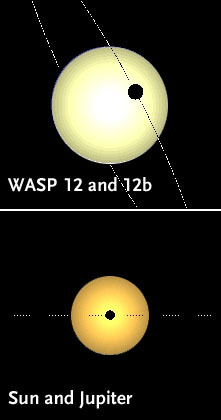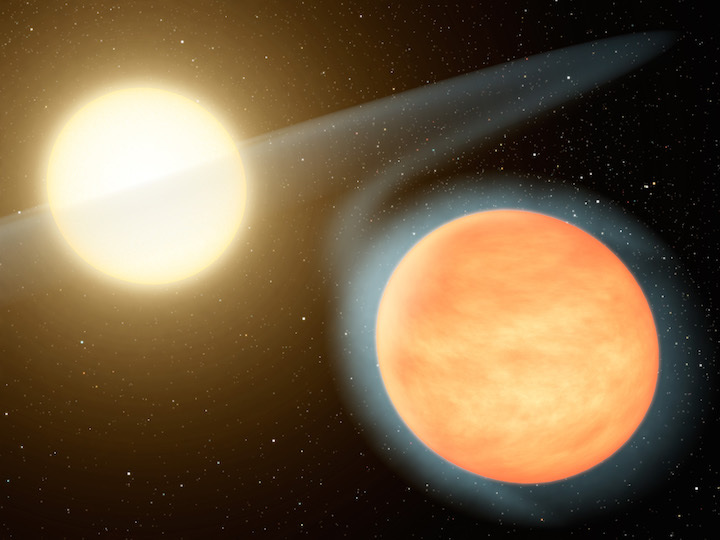4.09.2019

This artist’s view shows a hot Jupiter exoplanet in a tight orbit around its parent star.
NASA / JPL-Caltech
A mere 3 million years from now — a cosmic eye-blink away — the star WASP 12 might consume its exoplanet WASP-12b. According to Joshua Winn (Princeton University), it looks like astronomers are actually witnessing the enigmatic hot Jupiter as it slowly but steadily spirals inward. Winn presented the latest results on the planet’s apparent orbital decay on August 20th at the 4th Extreme Solar Systems conference in Reykjavik, Iceland.
WASP-12b is a puffed-up gas giant, transiting its Sun-like star every 1.1 days from a distance of just 0.02 astronomical units (a.u.), about nine times the Earth-moon distance. In 2017, a team led by Kishore Patra (University of California at Berkeley) announced that the planet’s orbit appears to be shrinking: The time intervals between successive transits across its parent star decrease by 29 milliseconds per year. So, since its discovery in 2008, the orbital period seems to have shortened by 0.3 seconds. Now, new evidence supports the idea that we’re viewing the last stage of this planet’s existence.
The Fate of Hot Jupiters

The star designated WASP 12, depicted in the upper panel, is tightly encircled by a large planet (black dot) that passes in front of and behind it. The planet, WASP-12b, has a diameter roughly 80% larger than that of Jupiter, seen projected against the sun in the lower panel.
Back in 1996, when the very first hot Jupiters had been discovered, Fred Rasio (Northwestern University) and his colleagues predicted that their orbits could very slowly decay due to tidal interactions with their parent stars. However, the rapid change in WASP-12b’s orbital period implies that we’re observing the planet at the last moments of its inspiral. That might seem a rather improbable coincidence, but David Latham (Center for Astrophysics, Harvard & Smithsonian) says, “one such case could be the result of a lucky accident.”
Alternatively, the planet’s orbit could be slightly eccentric. A change in the orbit’s orientation (known as apsidal precession) could then produce a gradual shift in transit times. But unless WASP-12b has a weird interior that somehow resists the tidal gravitational forces of its parent star, it’s hard to explain how its orbit can remain eccentric. Over time, those tidal interactions ought to have fully circularized the planet’s orbit.
Now, the latest Spitzer Space Telescope observations of the system, which is at a distance of 1,300 light-years in the constellation Auriga, argue in favor of the planet’s orbital decay. Spitzer observed not only WASP-12b’s transits in front of the star, but also its occultations, when it disappears behind the star. In the case of apsidal precession, the true orbital period doesn’t change, so if transits occur earlier than expected, occultations should occur later. In the case of orbital decay, however, the exact times of transits and occultations should both shift in the same direction.
The new observations support the orbital decay case, Winn says. According to Latham, the evidence that WASP-12b is going into a “death spiral” is indeed “quite convincing.” But, he adds, “I think it is too early to conclude that apsidal precession is excluded. In fact, I would not be surprised if both effects prove to be involved as further transit times are accumulated in the coming years.”
If the result is confirmed by future measurements, it would be the first time that astronomers are witnessing a hot Jupiter’s orbital decay. The new result fits in with earlier observations that revealed a large and steady mass loss of WASP-12b of some 10-7 Jupiter masses per year. Apparently, the planet’s demise has already begun.

Artist concept of the extremely hot exoplanet WASP-12b losing mass to its host star.
NASA / JPL / Robert Hurt
Asked about the importance of the find, Latham says: “A long-standing puzzle concerning the migration mechanism that produces hot Jupiters is, what stops the migration? Why does there appear to be a pile-up of orbits with periods of a few days for hot Jupiters? Does some physical mechanism halt the migration? Finding convincing evidence that one or two hot Jupiters are actually continuing in a death spiral would provide an important input to this discussion.”
Rasio says it’s still too early to call it a closed case. But if confirmed, he says, it means there must be many more hot Jupiters that have experienced a similar fate. “Their envelopes might get stripped, revealing a core that looks just like a super-Earth, or maybe a mini-Neptune if they can retain a bit of their envelope.” Many such planets have been found in very short periods, he says, and those may very well have formed through orbital decay of hot Jupiters.
Quelle: Sky&Telescope
